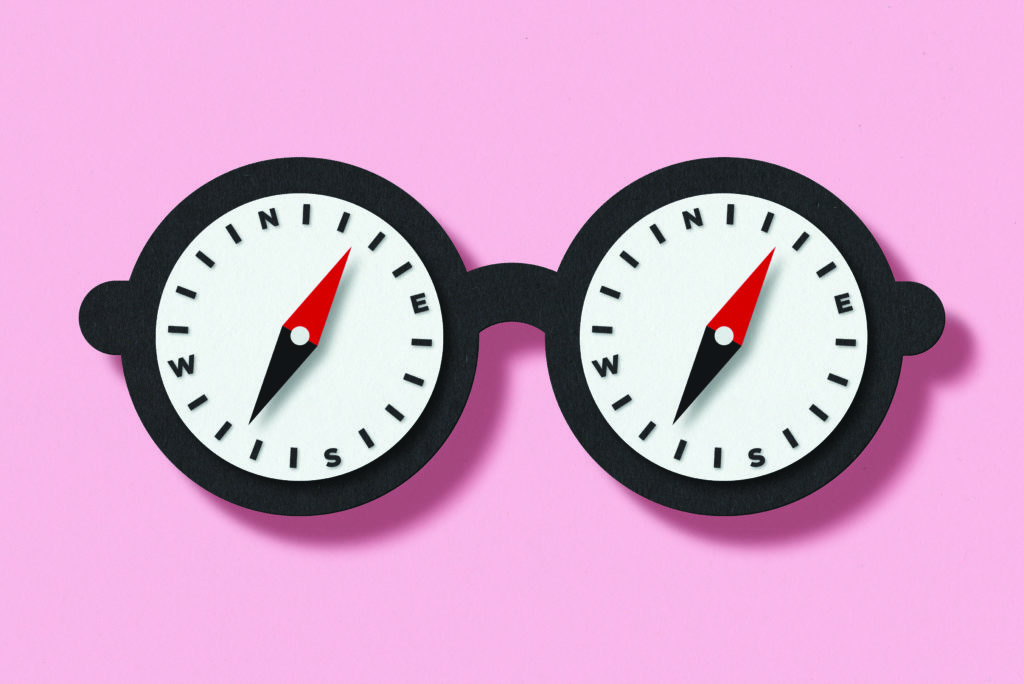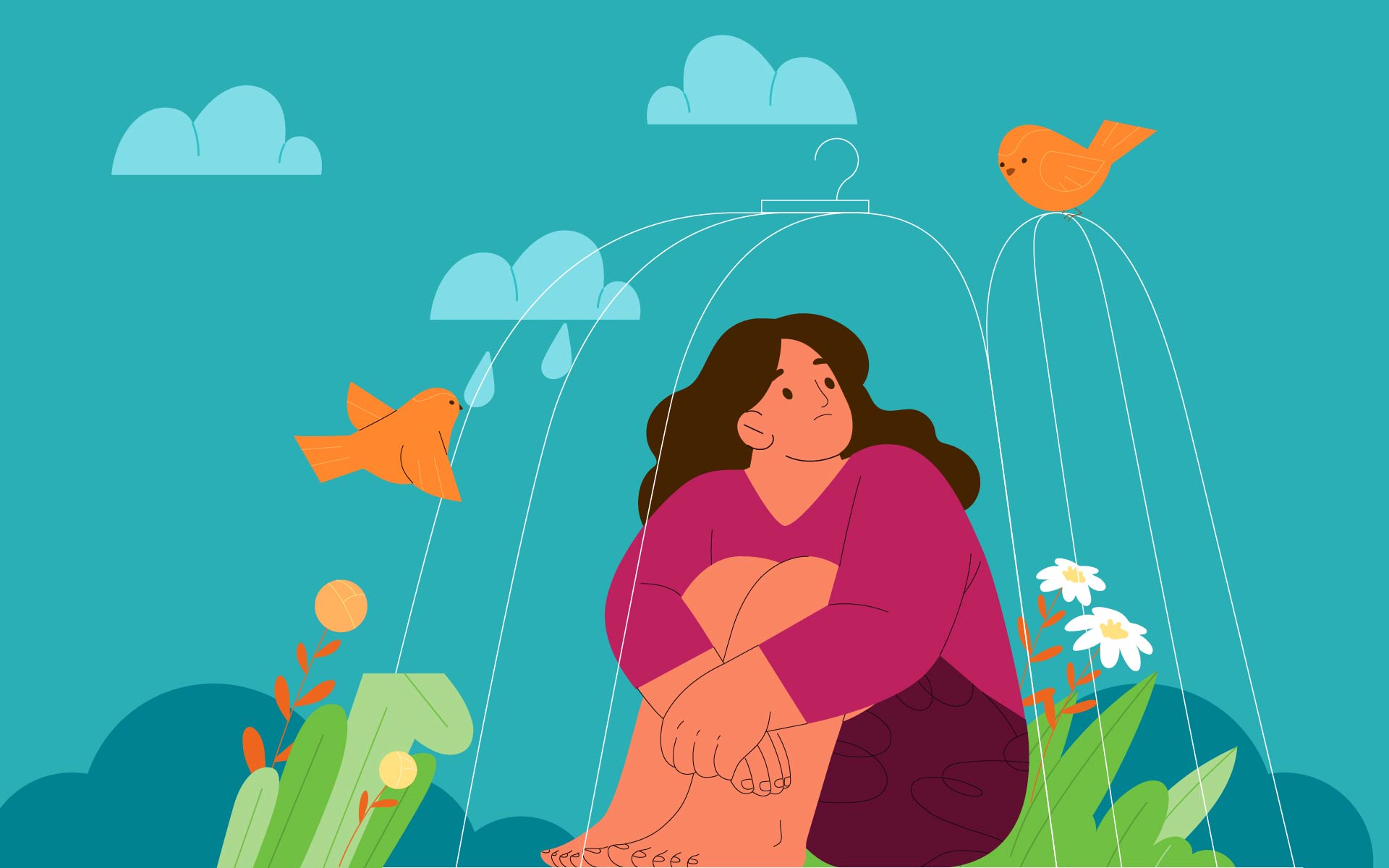You know those moments when things don’t go as planned—the job, the relationship, your health—and you feel unmoored and unsure of your next steps? Or, when things are going so well that there’s a sense of opportunity right at your fingertips? Those are the moments when having a clear sense of purpose can both anchor and guide you; it can also help you navigate the tricky in-between stages when your life feels a lot less clear, offering a sense of ease and skill and, dare I say, grace.
Uncovering your purpose is a process. In fact, I like to define purpose as an ongoing process of developing a clear understanding of what is most meaningful to you, and aligning your actions and behaviors in the world to be consistent with those qualities. It’s the skill of being in tune with your mind, heart, and body, so you can recognize when you’re about to stray from your path and find your way back on course. And, equally important, being clear can help you acknowledge those moments where your path and your purpose are aligned so you can celebrate them with gratitude.
The work of defining purpose is the work of becoming fully conscious of what you love and what is most alive within you and then acting accordingly.
Getting clear about your purpose is an internal practice of connecting with the sources of meaning, joy, and inspiration that reside deeply within you. The work of defining purpose is the work of becoming fully conscious of what you love and what is most alive within you and then (and this can be the hard part) acting accordingly. This work takes time, practice, imagination, compassion, curiosity, and kind awareness. It’s an evolving process, a beautiful and sometimes painful one, that you can be in relationship with over the arc of your whole life.
How I connected to my purpose
About nine years ago, I began experiencing a vague sense that I was misaligned in my work. I found myself dreading work, rather than feeling excited or engaged by it. Bad work habits began creeping in—I would heavily procrastinate on projects, not be responsive to emails. The quality of my work began to suffer as well. And the most troubling sign of all—my attitude and personality also began changing. I was no longer energetic and excited about work, instead a dullness took over and I became more and more stressed. This was especially problematic because I managed a team of people and my mood changes became increasingly apparent and affected some of them in negative ways.
I had spent years successfully building my career as an organizational psychologist working with some very interesting companies. My work was fulfilling for me personally and also provided me and my family security and stability. So I was feeling very confused about what to do next.
Thankfully, I had been practicing meditation since college. I knew that I needed to take time to sit in quiet reflection with all that was arising for me. As I did so over the course of the year, I came to realize that what I most wanted to do was focus full time on sharing the practice of mindfulness and meditation in organizations. It was so alive for me. But this was way before mindfulness was mainstream. And the thought of building a career teaching mindfulness in organizations sounded a little crazy.
Yet I couldn’t ignore what I was feeling.
At the time, I had an exciting job at Google, where I was responsible for providing leadership development programs for senior leaders across the company. It was a great role and represented the culmination of many years of hard work. I felt grateful and very lucky to have such a job—yet I couldn’t escape the feeling that my work was hurting me, physically and mentally. I was feeling depleted. My heart, mind, and body were saying “Focus more on your meditation practice, go deeper, see what’s possible,” but my logical mind couldn’t imagine quitting a job at Google. It took a lot of time to clarify my purpose and work up the courage and resolve to flip the script and take the big career- and life-changing step that I was considering next.
Eventually I chose to leave Google and cofound a workplace wellness and mindfulness company called WisdomLabs. It was a tough decision to leave, both because it meant a career transition and because it had real financial consequences for me and my family. But from the moment I stepped into this new role, I felt a sense of fulfillment that I had never experienced before. And over time the company began to make good on the vision of bringing mindfulness and wellness solutions to organizations around the world. Following my calling to offer mindfulness solutions to organizations continues to be a source of deep fulfillment for me to this day.
I eventually moved on to my current role leading the global nonprofit Search Inside Yourself Leadership Institute, which offers science-based mindfulness and emotional intelligence skills development solutions to communities and organizations around the world. Uncovering my purpose—which is to live and work toward the full integration of mindfulness in all domains of my life—and then acting on my discovery is how I created my reality today.
The journey to live your purpose is in a sense nothing less than a process of connecting with the aspects of your life and work that are most meaningful to you, and living and working in a congruent way. Importantly, this is a practice, a process, not a once-and-done.
That means it’s essential to check in regularly so you’re in tune with your current purpose and aware when changes naturally begin to crop up and require you to change course.
I’d like to share the practices that helped me create clarity about my purpose and my ongoing commitment to align my life with my discovery.
Exploring the Four Pillars of Purpose
There are four research-backed qualities that lead to a strong sense of purpose: awareness, values, aspirations, and congruent behaviors. The good news is that these qualities can be nurtured with simple mindfulness practices designed to activate these four “pillars of purpose.” Those practices are: awareness, to connect with what’s alive within you; intention, to visualize your best life; alignment, to match your actions with your values; and resilience, to unhook from rigidity.
How to Practice Awareness
1. Connecting with What’s Alive for You

Awareness simply means paying attention to the experience you are having as you are having it. You can practice awareness of your own sense of purpose through quiet meditation, taking the time to simply notice the thoughts, emotions, and physical sensations that arise when you consider your life and what purpose means to you. By observing your thoughts, emotions, ideas, sensations, discomfort, and anything else that arises, with kindness and curiosity, you can begin the process of discovery that can lead to insight into your purpose.
You can also integrate the practice of awareness into your everyday life. Ask yourself: What do you notice as you move through your day, or as you engage in tasks, meetings, or other forms of work? Is your life and work situation energizing? Draining? Does it sometimes bring feelings of joy or well being, or the opposite?
Remember that awareness practice is a process and that each phase, stage, and chapter of your life is a stepping-stone and a learning experience in which you can exercise awareness. Be kind to yourself as you bring curiosity to these large questions of purpose. We’re all unfolding. Life is a process. The fact that you’re interested in aligning your life with your purpose means that you’re already halfway there. Reflecting on purpose helps you gain insight into your own lived experiences and, when necessary, into how to respond appropriately and effectively to opportunities as they present themselves.
The fact that you’re interested in aligning your life with your purpose means that you’re already halfway there.
In both the formal meditation and integrated practices of developing awareness of purpose, the most important consideration is whether your life or work situation is contributing to a sense of aliveness for you. Perhaps more than anything, focusing on what makes you feel alive and energized is a key indicator of what is good and true and worthwhile to consider in terms of purpose. Aliveness can take many forms: joy, absorption, meaningfulness. I find that this concept of a search for what is most alive in one’s life is not only profound and beautiful but also very practical. You know it when you see, feel, or sense it!
How to Practice Intention
2. Imagining Your Best Life

Intention is your innate capacity to harness and direct your energy and effort at will. It seems simple enough, but it takes a lot of practice to harness your innate ability to direct your attention at will. And it’s also a critical skill for the journey toward realizing your purpose.
In many ways, setting the intention to live with purpose is an act of imagining an ideal future, and then living and working toward the realization of that vision.
Setting a clear and strong intention toward realizing purpose helps you to create the conditions for that purpose to arise. Some call this serendipity but there may be a more scientific explanation linking our thoughts and intentions with our behaviors. Neuroscientist Regina Pally describes how setting intentions (or goals) for yourself causes your brain to nonconsciously predict what is most likely to happen in order to achieve those goals. Then your brain becomes wired to act in ways consistent with those expectations. “According to neuroscience,” says Pally, “even before events happen, the brain has already made a prediction about what is most likely to happen, and sets in motion the perceptions, behaviors, emotions, physiologic responses, and interpersonal ways of relating that best fit with what is predicted.” In many ways, setting the intention to live with purpose is an act of imagining an ideal future, and then living and working toward the realization of that vision.
Setting intentions isn’t reserved only for things relating to your purpose with a capital “P.” Living a life of purpose means investing everyday moments with intention—which is why another key element in practicing intention is love. Having our intentions informed by love emphasizes the quality of how we are being in the world, rather than what we are doing. Bringing love to the mundane activities of everyday life is an invitation for each of us to live every day as our best selves. No matter what, intention imbued with love can bring us closer to a sense of congruence and alignment between what we value and how we act in the world.
How to Practice Alignment
3. When Your Actions Match Your Values

After you do the hard work of uncovering what’s alive for you, and setting the intention to direct your energy to incorporating those things in your life more, the next step is aligning your actions. It can be hard work: acting in a way that aligns with your values. It is sometimes all too easy to lose sight of what’s most important to you when you’re in the middle of the slings and arrows of everyday life. It is very easy to succumb to the “busyness trap,” or prioritize the needs of others over your own—to lose the forest for the trees. The days, months, and years pass by and there can be the surreal feeling or realization of “How did I get here? Where did my time go?”
It’s helpful to consider that all of the decisions and actions you take eventually help you better understand what alignment means to you. The very act of recognizing that you feel misaligned is the absolute necessary beginning point on the path to full alignment with your purpose.
The very act of recognizing that you feel misaligned is the absolute necessary beginning point on the path to full alignment with your purpose.
So, how do you know if you are living and working in an aligned way? In the simplest sense, it is about congruence. “Look closely at the present you are constructing; it should look like the future you are dreaming,” suggests Alice Walker, the renowned American writer and activist.
How do you know when you are on course to this “future you are dreaming”? I’d like to offer the following inquiry-based practice focused on the three “gates” that lead to aligned action.
How to Practice Resilience
4. Unhooking from Rigidity

Resilience is the learned capacity to bounce back from adversity, adapt, and thrive, according to world-renowned resilience expert Linda Graham. Learning resilience is critically important to realizing your purpose because it allows you to gracefully and effectively navigate the challenges you will certainly meet along the way. Challenges and setbacks are inevitable. I’d go as far as to say they are necessary: They force you to redefine and connect with your purpose in an even more meaningful way. That’s why the final pillar of realizing purpose is the ability to harness resilience to come back to your sense of purpose when you lose your way.
The good news is that more than five decades of research show that resilience is highly trainable. A mindfulness practice called response flexibility underpins the core research-backed resilience factors of optimism, balanced management of strong or difficult emotions, a sense of safety, and a strong social support system.
According to Graham, response flexibility is “the ability to pause, step back, reflect, shift perspectives, create options and choose wisely,” especially when we are met with adversity.
Your purpose is not some elusive hidden treasure that reveals itself all at once in a blaze of euphoria. Contemplating your purpose and taking aligned action is a process, a sometimes scary and painful process that unfolds over time. Sometimes long periods of time. Perhaps even the arc of a lifetime. As you live your way into a deeper understanding of what is true and good and meaningful for you, no matter how on or off course you might feel right now, you will gain the capability to acknowledge and invite new possibilities to live and work with awareness, intention and aligned action.
Developing your purpose is ultimately an exercise in imagination and creativity, because as the beloved Brazilian philosopher and educator Rubem Alves noted, “The frontiers of the possible are not determined by the limits of the actual.” What, then, is possible for you? Developing a sense of purpose for all that is possible (and not only what is actual) means listening deeply to your inner voice and connecting with what is most alive, true, and good in your life
read more
How to Tell if You Are Misaligned With Your Purpose
Three key ways to assess if you are aligned with your purpose—or not.
Read More
Noticing What’s Alive for You Right Now
Rich Fernandez, CEO of the Search Inside Yourself Leadership Institute, talks about how he leaned on his mindfulness practice to turn his career into a calling.
Read More
Uncover Your Purpose and Unleash Your Potential with Rich Fernandez
In this 4-part series, you’ll learn how to connect with what’s meaningful to you, set intentions for your future, define your purpose, and the ups and downs of the journey to living in alignment with your heart work.
Read More






